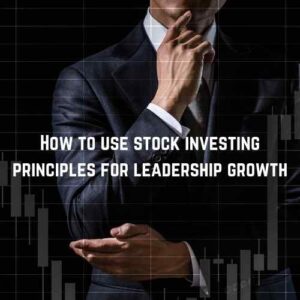05 Feb How to use Investing Principles for Leadership Growth ?

I’m sure many of you may have invested in stocks of a company or mutual funds sometime or the other.
So, if you have personally done stock investing , you may relate to these six investing principles that could be used while leading one’s team and organization.
1.Identify your employees with high, average and Slow growth
Have you noticed that not all stocks of companies have the same growth rate.
Especially a large cap stock will give a slower and lower return compared to a small-cap or mid cap. Similarly we cannot expect all employees to perform at the same level.
So its important to identify the high potential employees and put them on a faster track with critical projects, products, geographies and teams to manage.
As it has been observed that even stocks from the same sector, give different growth rates. Take for example in the IT sector in India, the highest return of 2810% in last 5 years was given by a young cloud communications company established in 1995.
So, If we show patience and stay invested in a high potential stock, it grows. Similarly if we invest our time and efforts in enriching role assignments, personally coaching and mentoring our high potential team members, they will surely grow like the proverbial Chinese bamboo tree.
So put an analytical framework and process to identify your high-potential employees at the earliest.
2.Show an Objective and Unbiased measurement of Current
Performance
Let me share with you the example of a well-known FMCG stock in India, which was once a high performer at some point in time but has given a negative return for last five years.
So If some employees were high performers in the past does not mean that they will continue to be a high performer.
Similarly, even if employees stay with your company for a longer tenure, it does not necessarily mean that they will give higher productivity or returns.
I remember that a reasonably experienced sales manager with 7 years experience generated 5+crores in sales in his second year working with an IT company than a senior sales manager who was with the company for 10 years.
Similarly as a manager and leader, you need to be open and unbiased towards younger generation performers.
You could look beyond the past high performers or long-tenured employees.
3. Uplift Undervalued Team Member
There are several stocks which are under-valued and have the potential to become a multibagger.
It is when Foreign and Domestic Institutional investors invest in it or pick it up, that the stock begins to fly.
Similarly, there could be employees or team members in your organization and department who could be feeling undervalued. They are waiting for you to give your attention and focus for them to fly in their performance and career.
4. Create an Encouraging Environment that produces breakthrough performance
As we all know that it is the collective mood or sentiments of the investors that determine the rise or fall of any stock.
Similarly all the leaders of the organization are responsible for either an encouraging or discouraging environment which either uplifts the sentiments and performance of the team or brings it down.
As an example, if you show impatience, you may lose a high potential stock by trying to make quick profits.
Similarly if you show impatience in getting results while at work it may result in some of your high-potential employees leaving you.
So as a leader it is your responsibility to manage the environment of your team and organization.
5. Invest in your own Leadership growth
We continue to keep growing our stocks as long as we continue to invest in our learning and education related to Stock Investing.
Similarly, we must keep educating ourselves by taking on additional projects both inside and outside the organization .
It also helps to sign up for practical courses to expand one’s capacity to lead.
It could be a globally recognized leadership program or a customized leadership development program spread over months and years.
6. Exit if the Culture affects your Leadership Performance
If some stock is a consistent non-performer due to change in its fundamental and corporate governance ,then it will be better to exit from that stock .
Similarly if you find that you are in a toxic and disengaging culture where your leadership performance is not recognized or affected, it could be a time for reflection and take your decision whether to stay or exit.
Summary of the Six Investing Principles for Leadership Growth
Trust these six principles of Leadership from Stock investing could help us to become more effective in our leadership growth.


No Comments